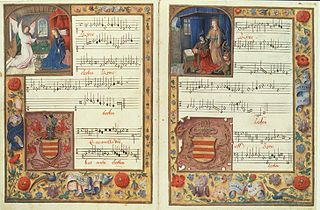The Toulouse Mass is a polyphonic 14th-century musical setting of the Mass found in a manuscript in the municipal library of Toulouse. It was not composed by a single individual, but is presumed to have been compiled and performed as a unit. The present location of Toulouse does not necessarily mean it was composed there.

The mass, a form of sacred musical composition, is a choral composition that sets the invariable portions of the Eucharistic liturgy to music. Most masses are settings of the liturgy in Latin, the liturgical sacred language of the Catholic Church's Roman liturgy, but there are a significant number written in the languages of non-Catholic countries where vernacular worship has long been the norm. For example, there are many masses written in English for the Church of England. Musical masses take their name from the Catholic liturgy called "the mass" as well.

Toulouse is the capital of the French department of Haute-Garonne and of the region of Occitanie. The city is on the banks of the River Garonne, 150 kilometres from the Mediterranean Sea, 230 km (143 mi) from the Atlantic Ocean and 680 km (420 mi) from Paris. It is the fourth-largest city in France, with 466,297 inhabitants as of January 2014. In France, Toulouse is called the "Pink City".
Contents
It is not completely clear whether the Mass portions included in the manuscript were intended as a complete polyphonic setting of the Mass, or merely represent isolated movements. They were inscribed in empty spaces in a manuscript that otherwise contains plainchants and texts. The manuscript is also missing a polyphonic Gloria in excelsis Deo and Credo. However, it does include a note identifying a motet on Ite, missa est following the Sanctus and Agnus Dei (which appear adjacently in the manuscript). The manuscript also has part of a tenor line from a Credo that appears in both the Ivrea Codex and Apt Codex, as well as the Barcelona Mass, so perhaps that movement was used as well. It is also possible there never were supposed to be a Gloria or Credo with the Mass; some plainchant Masses omit them.

"Gloria in excelsis Deo" is a Christian hymn known also as the Greater Doxology and the Angelic Hymn/Hymn of the Angels. The name is often abbreviated to Gloria in Excelsis or simply Gloria.
A credo is a statement of religious belief, such as the Apostles' Creed. The term especially refers to the use of the Nicene-Constantinopolitan Creed in the Mass, either as spoken text, or sung as Gregorian chant or other musical settings of the Mass.
In western music, a motet is a mainly vocal musical composition, of highly diverse form and style, from the late medieval era to the present. The motet was one of the pre-eminent polyphonic forms of Renaissance music. According to Margaret Bent, "a piece of music in several parts with words" is as precise a definition of the motet as will serve from the 13th to the late 16th century and beyond. The late 13th-century theorist Johannes de Grocheo believed that the motet was "not to be celebrated in the presence of common people, because they do not notice its subtlety, nor are they delighted in hearing it, but in the presence of the educated and of those who are seeking out subtleties in the arts".
The Mass was composed somewhat after the Tournai Mass, the earliest known such Mass. It is in "song style," where only one voice has a text, and has three voices; as opposed to the "simultaneous style" of the Tournai Mass. Some of the pieces seem to have been adapted from motets, however.
The Tournai Mass is a polyphonic setting of the mass from 14th-century France. It is preserved in a manuscript from the library of the Tournai Cathedral.
- The Kyrie is found in the Ivrea Codex as well, and a trope on it is in the Apt Codex.
- The Sanctus has a contratenor and cantus in the same range and with the same rhythmic formulas, which implies that it may have been a three-voice motet with one of the texts removed.
- The Agnus Dei uses the trope Rex immense pietatis (King of infinite mercy), and is the clearest use of "song style" in the Mass.
- The motet on Ite, missa est uses the text Laudemus Jesum Christum (Let us praise Jesus Christ). Unlike ordinary motets, it has only one line with text (thus the "song style"). It also resembles a four-voice motet with a part missing, perhaps omitted in order to match the style of the other pieces.

Kyrie, a transliteration of Greek Κύριε, vocative case of Κύριος (Kyrios), is a common name of an important prayer of Christian liturgy, also called the Kyrie eleison.
The Sanctus is a hymn in Christian liturgy. It may also be called the epinikios hymnos when referring to the Greek rendition.

Ite, missa est are the concluding Latin words addressed to the people in the Mass of the Roman Rite, as well as the Lutheran Divine Service. Until the reforms of 1962, at Masses without the Gloria, Benedicamus Domino was said instead. The response of the people is Deo gratias.











